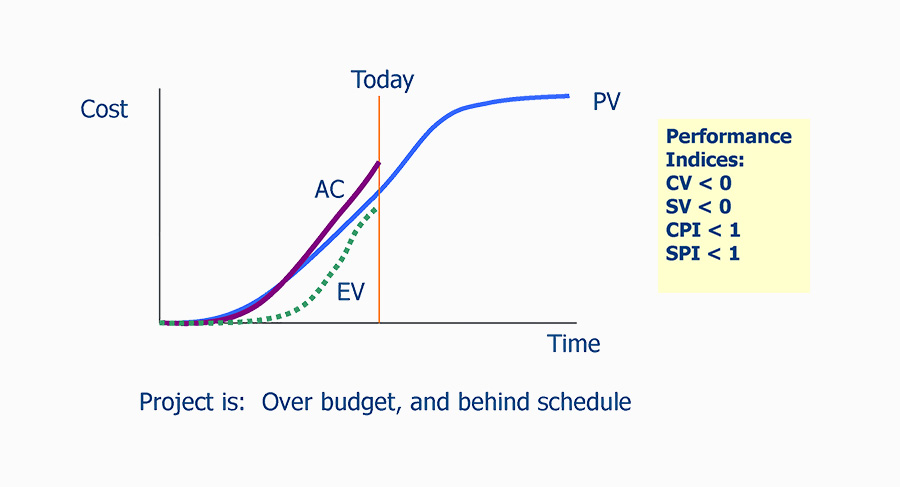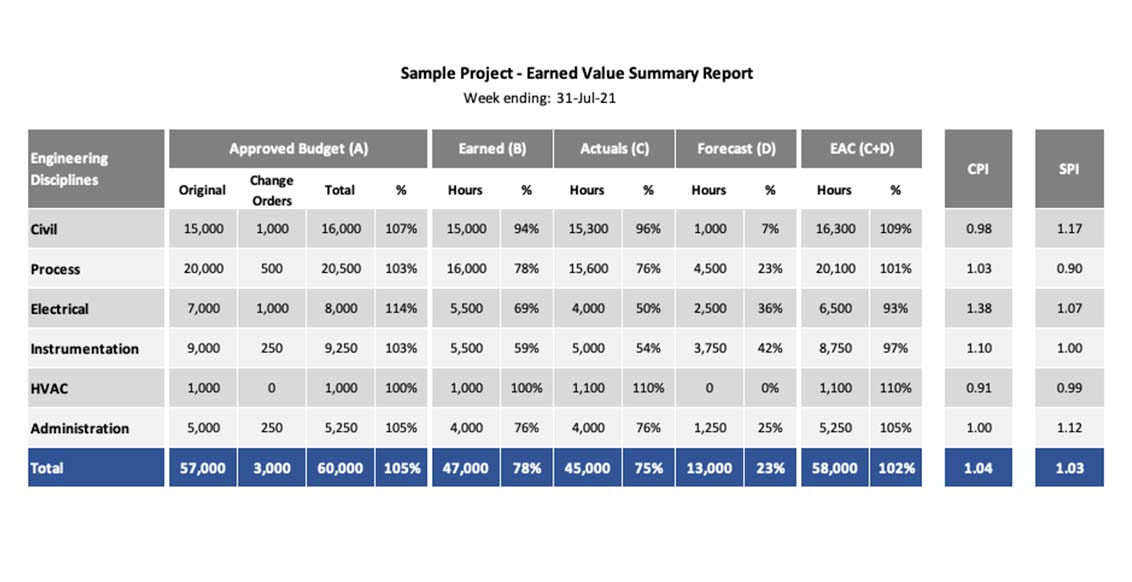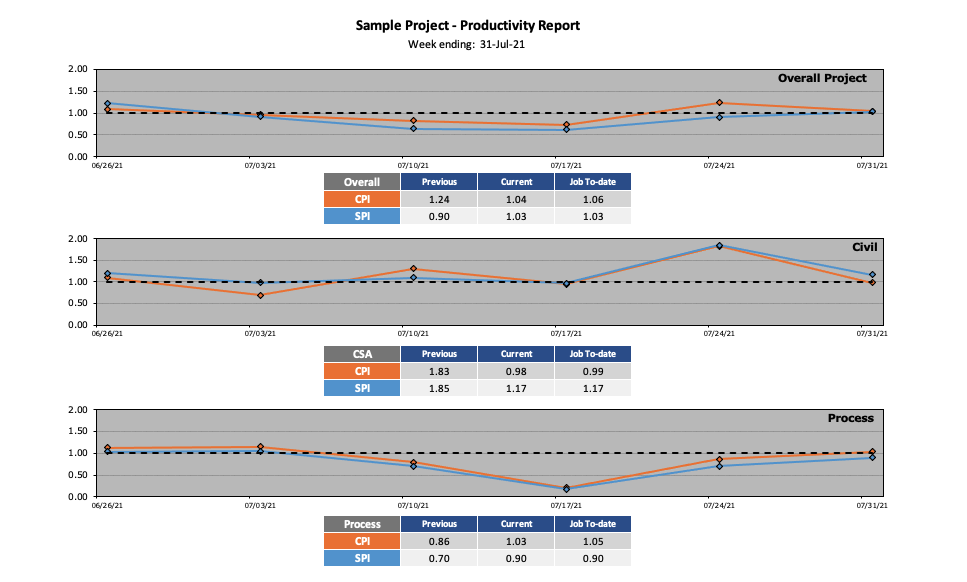Every project controls professional knows this maxim: “if you can’t measure it, you can’t control it.” But how do we measure conditions that are constantly changing? How do we show the relationships that not only give us an accurate picture of the project at a point in time, but also show us where it’s headed unless we intervene?
With Earned Value Management (EVM), we can meet those challenges. EVM unites the two most important factors in project success—time and cost—and allows all project stakeholders to compare project performance against the project baseline. Most importantly, EVM makes possible a realistic forecast of where the project is going if current trends continue.
What are the key indicators used in EVM?
Planned Value (PV)
The work you plan to complete within a designated time frame. The cumulative budget is plotted on a time axis (x = time; y = cost) showing when the expenditure is supposed to occur in the project schedule.
Actual Cost (AC)
The amount you spent for the work completed by the designated date. These costs are plotted on a time axis showing when actual funds were expended.
Earned Value (EV)
The cumulative plot of the value of the work performed based on the budget value of the items performed, also plotted on a time axis.
How does EVM work?
You can analyze your project’s cost and schedule performance using these key EVM metrics which are based on the following formulas:
Schedule variance (SV)
The difference between the actual work done against the plan. Schedule variances shows if the project is on track or behind schedule with the formula: SV = EV – PV
An SV of zero means the project is on schedule. A negative or positive variance means it is behind or ahead of schedule, respectively.
Cost variance (CV)
The difference between Earned Value EV and the Actual Cost AC using the formula: CV = EV – AC
A CV of zero means the project is in line with the approved cost. Negative and positive variance indicates the project is going over and under the budget, respectively.

Schedule performance index (SPI)
The ratio between the Earned Value EV and Planned Value PV using the formula: SPI = EV/PV
If the value of SPI is greater or equal to 1, it means the project is on track. Less than 1 indicates a deviation from the scheduled budget.
Cost performance index (CPI)
Defined by PMI as the measure of project cost efficiency, it is a ratio obtained with the following formula: CPI = EV/AC
Budget at completion (BAC)
Represents the original project budget.
With these calculations, we can estimate the project’s remaining costs and begin the process of forecasting and deriving an estimate of the resources required for project completion.
How do we forecast project performance and calculate Estimate at Completion (EAC)?
In the classic Earned Value scenario, the current CPI will continue for the rest of the project without rebaselining: EAC = BAC /CPI where CPI = EV/AC
We can also see the current cost performance over the entire project with rebaselining: EAC = AC + [(BAC-EV) ÷CPI
In the case where future work is seen to revert to planned performance levels as impacts/delays are over: EAC = AC + (BAC-EV)
These are three of the more commonly used formulas to calculate EAC, but there are others, including one if the schedule performance index (SPI) is needed to adjust for shifts in the project schedule.
Although data analysis is retrospective in nature, forecasting should reflect the best vision of future performance, knowing what past performance looks like. Forecasts should be realistic based on reliable data from actual scenarios.
Ask the Experts
We sat down with PMA’s Jerry Klanac and Reniz Moosa to discuss EVM practice in the real world of construction management.
How does Earned Value Management alert project managers to potential problems ahead?
Jerry: EVM acts like the first indicators on your dashboard telling you something is going wrong. If you want to use a car analogy, here’s the red light going on to alert you of engine trouble. So, you have to figure out what part of the engine is in trouble. That’s the concept of Earned Value Management. It gives you the warning. You know something’s going astray, and then once you watch and identify what it is, then you’ve probably got a couple of remedy options to correct that.
Reniz: Of course, EVM analysis is only as good as the data used to create it. Accurate input from each discipline is essential for meaningful analysis & corrective actions.
Jerry: Seeing the EVM results and then comparing the actual performance over recent reporting periods against what was planned from a really good CPM schedule will tip you off to what types of activities are falling behind.
Reniz: As an example, here is a table showing Earned Value for all the disciplines in a project for which we are providing EVM reports:

Here you can see the disciplines; the budget that has been approved; and the Earned Value for each. Earned Value is how much work you can take credit for; actuals is the actual amount charged in the timesheet. Here they have earned 47,000 hours but charged 45,000 hours. The whole point is to understand your EAC (Estimate at Completion)—what we are trying to tell the client is here we are already 3 percent ahead of the curve; at the end we will be 3 percent under. This is what CPI and SPI do. If CPI is above 1, it’s an indicator that you are going to be under budget and if SPI is above 1, it’s an indicator that you finish ahead of schedule.
Here is the other way of showing this data: this is how we have been progressing the data on a week-to-week basis. And we do this for each discipline.

There will be ups and downs in a project throughout, so this gives them an indication of how they’re performing.
Jerry: You apply the earned value concepts to either individual contracts or individual disciplines of work if you can. This is possible if your cost systems and schedule systems are aligned; that’s why having a common work breakdown structure that uses both breakdowns is useful. You may find there are one or two contracts, or disciplines/trades that are the most problematic. And then you know what you have to do is drill down and find out, why is that particular work not going so well?
Reniz: In the sample example provided, the scope is broken down at the discipline level which gives the client the ability to understand which discipline is not performing after which they can further drill down to investigate the reasons for non-performance. This way the owner also gets a heads-up, much in advance, if more money is needed to complete the project.
How can we bring a project back on track?
Jerry: When the red light shows up on the EVM dashboard and you think ‘I need to improve my schedule performance’ you’ve got many possibilities to consider. The most straightforward option is to add more resources.
You may also want to look at how you sequence the work, and if there’s some fine-tuning you can do with that sequencing to overlap more work. You need more people because you’re doing many more tasks simultaneously. Another choice is to try to increase the amount of time being spent per week. So, whether or not you’re working overtime, multiple shifts are another way.
Reniz: We can also produce an FTE graph as shown below which is literally the number of people you need to do your work. So if the suggested measure to bring the project back on track is to add more resources to the team, we can use this graph to understand when and how many resources need to be added.
Jerry: You also look at the productivity of the workers and see if there are some aspects of the management of the work that can be improved. Sometimes the workers are waiting on materials or drawings, sometimes they need training or better tools, or the procedures to do the work are not clear and if you relieve those kinds of bottlenecks, productivity will increase.
Reniz: It’s not just about saying ‘OK, you’re doing bad—end of story.’ We can drill down and tell you where exactly the problem is. In one case, one discipline was clearly falling behind and we knew why. They were getting incomplete information from another source. There was a lot of rework that had to be done. After we focused on them, three months later, the situation improved.
How well do owners and project leads really understand Earned Value Management? Are they expecting it on a project or is it something PMA Consultants brings to the table?
Reniz: With one of our clients, EVM was why PMA was brought in. It was in their contract with the owner that they use it. EVM, which is a form of predictive analytics, is something PMA understands very well. This client found the EVM analysis so beneficial, that we continue to provide this service to-date even for projects that don’t have it mandated in their contract.
Jerry: An owner that truly understands the value inherent in the process will be expecting it. EVM resembles other types of reporting up the chain of command. Clients depend on this information so they can aggregate the state of many projects in a portfolio and see which ones are on track and which are not.
For some owners, Earned Value Management can be a somewhat new approach. They’ve been centered in business management rather than project management. They may not have been exposed to these principles explicitly. However, once it’s explained, they tend to like it because they’ve already been weaned on certain types of metrics to look at business performance, and it’s the same type of thinking, just applied to a project.
Of course, Earned Value Management can be a more complex and complicated endeavor than presented in this short overview. Unmatched expertise in EVM and expansion of the client’s knowledge base for its implementation are among the many attributes PMA professionals bring to the table. Thanks to Jerry and Reniz for giving us a brief look at EVM in practice.